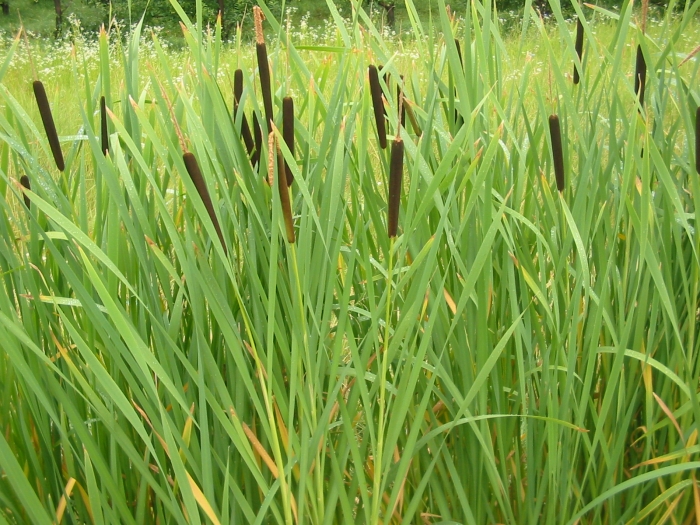Broadleaf Cattail
(Typha latifolia)
Broadleaf Cattail (Typha latifolia)
/
/

User:Bogdan
CC BY-SA 3.0
Image By:
User:Bogdan
Recorded By:
Copyright:
CC BY-SA 3.0
Copyright Notice:
Photo by: User:Bogdan | License Type: CC BY-SA 3.0 | License URL: http://creativecommons.org/licenses/by-sa/3.0/ | Uploader: Bogdan | Publisher: Wikimedia Commons | Title: Typha_latifolia_02_bgiu.jpg | Notes: User created page with UploadWizard |













































































Estimated Native Range
Summary
Typha latifolia, commonly known as Broadleaf Cattail, is a perennial herb native to a wide range of wetland habitats including marshes, wet meadows, pond edges, and riparian areas across all continents except Australia and Antarctica. It typically grows to a height of 5-10 feet (1.5-3 meters) with a spread of 2-4 feet (0.6-1.2 meters). Broadleaf Cattail has a distinctive appearance with its tall, stiff stems topped by brown, sausage-shaped flower spikes that appear in summer and are highly recognizable. The plant also features flat, blade-like leaves that can be up to 1 inch (2.5 cm) wide.
Broadleaf Cattail is valued for its ability to stabilize soil and provide habitat for wildlife. It is often used in wetland restoration, erosion control, and as a water filtration plant in constructed wetlands. It thrives in full sun to part shade and requires high amounts of water, making it suitable for bog gardens and the edges of water bodies. It is adaptable to a range of soil types, including those with slow, medium, or fast drainage. While Typha latifolia is easy to establish from bare rootstock, seedlings, or direct seeding, it can be potentially invasive outside its native range, particularly in Australia and Hawaii where it is considered a noxious weed. Care should be taken to manage its spread to maintain ecological balance.CC BY-SA 4.0
Broadleaf Cattail is valued for its ability to stabilize soil and provide habitat for wildlife. It is often used in wetland restoration, erosion control, and as a water filtration plant in constructed wetlands. It thrives in full sun to part shade and requires high amounts of water, making it suitable for bog gardens and the edges of water bodies. It is adaptable to a range of soil types, including those with slow, medium, or fast drainage. While Typha latifolia is easy to establish from bare rootstock, seedlings, or direct seeding, it can be potentially invasive outside its native range, particularly in Australia and Hawaii where it is considered a noxious weed. Care should be taken to manage its spread to maintain ecological balance.CC BY-SA 4.0
Plant Description
- Plant Type: Herb
- Height: 5-10 feet
- Width: 4-6 feet
- Growth Rate: Rapid
- Flower Color: N/A
- Flowering Season: Summer
- Leaf Retention: Deciduous
Growth Requirements
- Sun: Full Sun, Part Shade
- Water: High
- Drainage: Fast, Medium, Slow
Common Uses
Bird Garden, Border Plant, Deer Resistant, Erosion Control, Potted Plant, Salt Tolerant, Water Garden
Natural Habitat
Wide range of wetland habitats including marshes, wet meadows, pond edges, and riparian areas
Other Names
Common Names: Common Bulrush , Cooper’s Reed , Soft-Flag , Common Cattail , Great Cattail , Giant Reed-Mace , Great Reedmace , Cat-O’-Nine-Tails , Broad-Leaved Cattail , Cumbungi
Scientific Names: Typha latifolia , Massula latifolia , Typha latifolia var. ambigua , Typha intermedia , Typha media , Typha angustifolia var. media , Typha latifolia f. latifolia , Typha ambigua , Typha angustifolia var. sonderi , Typha latifolia var. angustifolia
GBIF Accepted Name: Typha latifolia L.